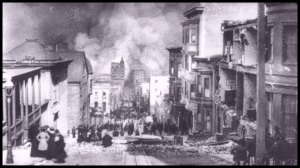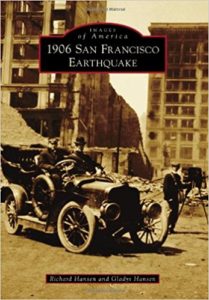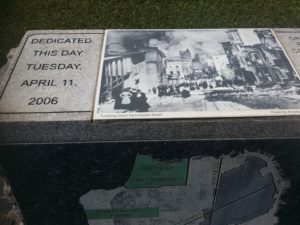“Everything you knew about the 1906 earthquake was a lie or an inaccuracy. If you repeat a lie long enough, it becomes the truth.” ~ James Dalessandro, San Francisco historian
“An enumeration of the dead will never be made. All vestiges of them were destroyed by the flames. The number of victims of the earthquake will never be known.” ~ Jack London, The Fire, 1906
The San Francisco earthquake of 1906 was regarded as the greatest American natural disaster until Hurricane Katrina in 2005. The shock waves are estimated to have been as high as a magnitude 8.3 on the modern Richter scale. Of the 400,000 residents of the city, over half were homeless. The ferocious shaking knocked out most gas and water lines, which created a perfect three-day storm of fires with hardly any water to extinguish them.
After the earthquake there was an urgent need for the city to reassure potential developers and settlers that San Francisco was still a thriving urban area dedicated and able to sustain dynamic growth. The Great Earthquake was followed by the Great Cover-Up.
There was an immediate effort following the event to reduce its negative publicity impact by controlling how and what information was disseminated. Reporters were asked to describe the disaster as a fire, and not an earthquake. Financial institutions would invest in a city that suffered a fire (such as Chicago in 1871, which quickly rebuilt) because all urban clusters are subject to fires, but an earthquake was a different matter – a capricious act of God that could no more be predicted than comprehended. What if San Francisco was suddenly earthquake prone? As a confidence-boosting project, the city hired writers to craft positive stories, sometimes ignoring claims of human death, and downplaying the connection and effect the earthquake had on the fires.
The destruction of City Hall
Although Mayor Eugene Schmitz created a committee on history and statistics to compile a scrupulous earthquake history, no official report was ever produced from the voluminous material collected, and now virtually all that material has vanished. How did this happen? No one knows for certain. One theory is that much of the material was lost or displaced in the great Berkeley fire of 1923. Many are convinced that the Southern Pacific Railroad sought through a cover-up to soften the impact of the crisis because of its vast landholdings and hauling business in California generally, and San Francisco in particular. Its monthly magazine, Sunset, ran optimistic and misleading stories about the fires with hardly a mention of the earthquake itself. Could it have helped to orchestrate a destruction of the committee evidence? Insurance companies were known to buy the rights to any photographs of the disaster it could find. Perhaps they, too, were involved.
Whatever the truth, the disappearance of the materials fed the conspiracy theory that the report was deep-sixed by influential people who wanted to suppress evidence and facts about the disaster to protect the civic reputation and future progress of the city. There was, at the very least, a conspiracy of silence and accommodation.
Shortly after the calamity, the Board of Supervisors quickly fixed the count of dead at 478, and although there was some initial skepticism at the low figure, eventually it was generally assumed to be correct. Even when remains of additional bodies were discovered as the ruins were cleared, and known residents had disappeared and were never found, that official assessment remained unchallenged until 1964 when Gladys Hansen, the new research librarian at the San Francisco Public Library’s Special Collections, began compiling a catalogue of the dead, since the 478 statistic never came with a list of specific victims.
Through her exhaustive investigations, including the solicitation of inquiries from the public, we have come to substantially change our view of the Earthquake and its human devastation. Hansen went through all the newspapers from April 18, 1906 to May 18 of the following year. She enlisted the help of Frank Quinn, the retired city registrar of voters, who examined the department of vital records, the health department and the coroner’s office. Additionally, she scoured city directories, old maps, and church records. One journalist described her effort as “doing detective work for the bureau of missing persons.”
Books by Gladys Hansen
Throughout this arduous process she was aided by her son, Richard, who has become a leading authority and author of the calamity. As a direct result of the Hansen research, the San Francisco Board of Supervisors took the occasion of the 100th anniversary of the earthquake to officially set the number of dead at 3,000. Both Gladys and Richard Hansen believe that further research will reveal more victims, perhaps doubling the current figure.
In 2006, Cypress Lawn dedicated a memorial to the earthquake victims who were acknowledged through the work of Gladys Hansen. She was cremated at Cypress Lawn in 2017 and her ashes scattered. There are plans next year to have a tribute celebration of her life at Cypress Lawn and a memorial stone erected in her honor near the spot of the Earthquake memorial. Richard Hansen will officiate.
It is amazing the difference one person can make.
Terry Hamburg, Cypress Lawn Heritage Foundation








Bravo, Richard. Wonderful tribute to what happened in 1906, and to your mother and her tireless efforts to get at the truth. James Dalessandro
Wonderful tribute to you mom and to the ultimate victim of the 1906 disaster – the truth about what really happened.
Thank you so much for this. My grandparents and two of their children (my aunts) survived the earthquake I heard stories from my grandmother when I was young.
Thank you. We have Gladys’ informative book. She was such a wonderful historian and San Francisco misses her. My grandmother and grandfather survived the ’06 earthquake and were married 3 months later.
It was a cover-up to destroy tartarian buildings of the past.
It was a cover-up to destroy the tartarian buildings from the past.
Just became aware of tartarian buildings around the world and how they have either been destroyed or presented as recently constructed buildings. I highly suggest everyone to open their minds and their eyes to all the lies we have been told about our history and the remnants that still stand(or lie underneath) today..